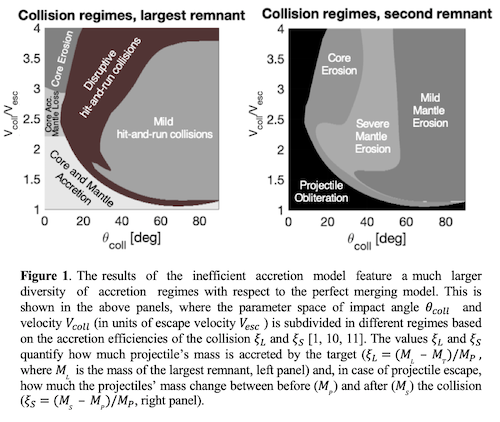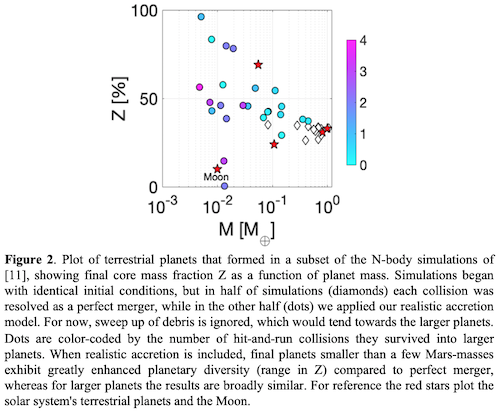The Effect of Inefficient Accretion on Planetary Differentiation
- 1Lunar and Planetary Laboratory, The University of Arizona, United States of America (cambioni@lpl.arizona.edu)
- 2Department of Earth and Environmental Sciences, Michigan State University, United States of America
- 3Bayerisches Geoinstitut, Universität Bayreuth, Germany
- 4School of Earth and Space Exploration, Arizona State University, United States of America
- 5Systems and Industrial Engineering Department, The University of Arizona, United States of America
Summary: Inefficient accretion is a common outcome of planet-planet collisions which dominate the late stage of terrestrial planet formation [1]. These giants impacts create deep magma oceans on the resulting bodies [2], thus promoting multi-step core formation [3]. Here we present how planetary differentiation is affected by inefficient accretion and compare the results to those obtained assuming that collisions are perfectly accretionary (“perfect merging”). We find that the two models provide similar predictions for the mass and core mass fraction of planets more massive than 0.1 Earth’s masses (~1 Mars’ mass), in agreement with previous studies [4]. At smaller scales, however, the inefficient accretion model predicts a higher degree of planetary diversity in terms of core mass fraction. Smaller final planets, by definition, do not participate in many merging giant impacts but may participate in multiple hit and run collisions as either the target or the runner, both of which may leave a strong signal in a small planet's composition. Alternatively, due to the more extensive growth history of larger final planets, these regress to an average composition through the incorporation of many smaller embryos, effectively erasing gross signatures of hit and run collisions.
Why we need to model inefficient accretion: Planet formation models typically assume that, when a target of mass MT accrete a projectile of mass MP, the resulting planet has mass MT + MP (e.g., [5]). However, numerous studies show that the projectile often manages to escape accretion (hit-and-run collisions, [6]) and substantial debris can be produced (e.g., [7, 8, 9]). We capture this effect using machine learning [10, 11]. We train neural networks to predict the outcome of the collision (mass of the resulting bodies, their post-impact orbits and core-mass-fractions) from knowledge of the impact properties (target’s and projectile’s masses, and impact angle and velocity). The training, validation and testing set is a large but sparse collection of high-resolution Smoothed Particle Hydrodynamics simulations of giant impacts. We combine the neural networks with rigorous planetary differentiation models ([12, 4]) to study how the chemical equilibrium between the Si- and Fe-rich liquids (the planets’ mantle and the core, respectively) evolve as the pressure, temperature and oxygen fugacity of metal silicate equilibration change because of a giant impact. We assume that every collision is energetic enough to re-equilibrate the planets’ reservoirs. Future work will aim to relax this assumption.
Inefficient accretion versus perfect merging: We first present a case study of a single collision solved using the inefficient accretion model trained on impact simulation data (Figure 1). Where the perfect accretion model would feature a single regime, i.e., the two bodies are assumed to merge in all scenarios, impact simulation results exhibit a richer range of potential outcomes as a function of expected pre-impact conditions. As terrestrial planets conclude their formation in a series of giant impacts [1], we also study the cumulative effect of such collision chains on the final planets' core mass fraction (Figure 2) using some of the results of the N-body planet formation studies in [11]. These simulations start with the same initial conditions, but in half of them collisions are resolved as perfect merging, while in the other half collisions are modelled using the neural networks. We find that the final planets’ core mass fractions predicted by the inefficient accretion model (dots) agree with those of the perfect merging model (diamonds) for planets’ masses larger than 0.1 Earth masses. This is consistent with previous studies that successfully reproduced Earth’s Bulk Silicate abundances using the results from N-body with perfect merging [4]. At smaller scale, however, the diversity in core mass fraction is enhanced in case inefficient accretion is included. The “degree” of diversity is higher for planets that survived a higher number of hit-and-run collisions, thus linking the collision history of planets to their core mass fractions.
Take home message: Our findings confirm that giant impacts are powerful drivers of planetary diversity, especially for planets less than a few tenths the mass of the largest, e.g. Mars-mass planets in our solar system. A realistic treatment of planetary collisions in terrestrial planet formation is necessary to accurately track compositional evolution.
References: [1] Asphaug, E. (2010). ChEG, 70, 199-219, 2010. [2] Tonks, W. B., & Melosh, H. J. (1993). JGR: Planets, 98(E3), 5319-5333. [3] Rubie, D. C., and S.A. Jacobson (2016). Deep Earth, 217:181-190. [4] Rubie, D. C. et al. (2016) Science 353.6304: 1141-1144. [5] Chambers (2001). Icarus, 152(2), 205-224, [6] Agnor, C., & Asphaug, E. (2004), ApJL, 613, L157. [7] Kokubo, E., & Genda, H. (2010), ApJL, 714, L21; [8] Stewart, S. T., & Leinhardt, Z. M. (2012), ApJ, 751, 32. [9] Burger, C et al. (2018), Celest. Mech. Dyn. Astron., 130, 2. [10] Cambioni, S., et al (2019). ApJ, 875, 40. [11] Emsenhuber, A. et al., (2020) ApJ, 891, 6. [12] Rubie, D. C., et al. (2015). Icarus 248: 89-108.


How to cite: Cambioni, S., Jacobson, S. A., Emsenhuber, A., Asphaug, E., Rubie, D. C., Gabriel, T. S. J., Furfaro, R., and Schwartz, S. R.: The Effect of Inefficient Accretion on Planetary Differentiation, Europlanet Science Congress 2020, online, 21 September–9 Oct 2020, EPSC2020-407, https://doi.org/10.5194/epsc2020-407, 2020

